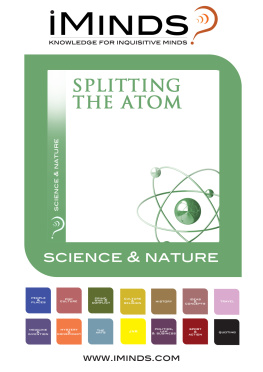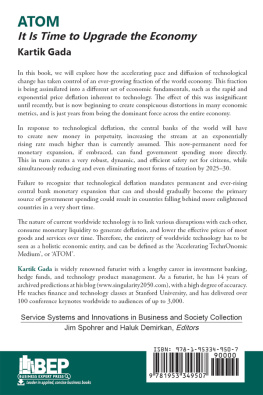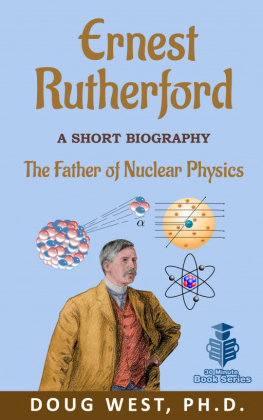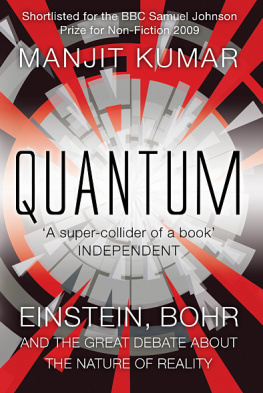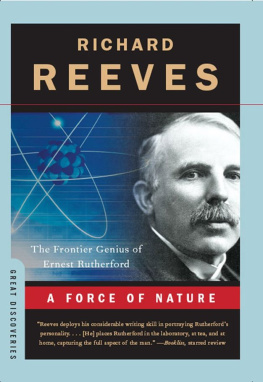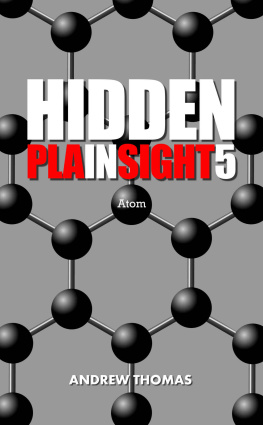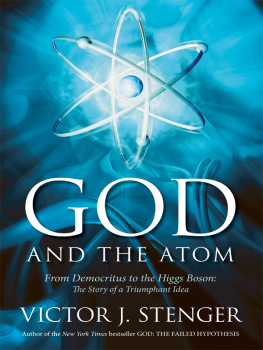Contents
Published by Icon Books Ltd, Omnibus Business Centre, 3941 North Road, London N7 9DP
Email:
www.introducingbooks.com
ISBN: 978-1-78578-216-9
The author has asserted his moral rights
Text copyright 2007 Piers Bizony
No part of this book may be reproduced in any form, or by any means, without prior permission in writing from the publisher.
PART ONE
Energy in Pieces
In the year 1900 a deeply conservative physicist called Max Planck concluded, somewhat reluctantly, that energy is not smooth and continuous. It is divided into discrete amounts, mysterious packets, which he called quanta. It was a discovery that would revolutionise all of science.
The word atom is derived from a Greek idea formulated 2,400 years ago. The philosopher Democritus argued that matter is made from indivisible, imperishable and unchanging particles, which he called atomos. It was a brilliant insight, based on logical argument, but Democritus did not choose to test any of his concepts experimentally. Like most of his contemporaries, he thought that logic alone should be able to resolve the mysteries of nature. During the next 22 centuries the atom made almost no impact on the human imagination, until a precocious young teacher at the dawn of the Industrial Revolution discerned the hard-edged practical value of talking about atoms. John Dalton was born in 1766 into a modest Quaker family in Cumberland, and earned his living for most of his life as a teacher, first at his local village school (where he began giving classes at the age of twelve) and then in the factory-dominated city of Manchester. Here he reanimated the atomic theory in a strict mathematical framework rather than just as a vague philosophical idea. He concluded that all atoms of a given element must be identical to each other, and argued that chemical compounds are formed by a combination of two or more different kinds of atoms. Carefully weighing his chemicals before and after they reacted with each other, he worked out the ratios of different elements that went into certain well-known compounds. The atom emerged from his work as a spectacularly reliable chemical counting unit. As a statistical way of looking at gas and steam pressures, the atom was also invaluable. Yet it remained, for now, just that: a workable counting tool with no proper physical explanation behind it.
By the end of the 19th century, a self-confident set of rules had been assembled to describe just about everything that could be looked at, listened to, weighed or measured: the precise movements of the stars and planets across the sky, the temperatures and pressures of gases under given conditions, the rate of transfer of heat from one substance into another, the equations for shaping glass lenses so that they would bring rays of light to a focus, and so on. It was a mechanistic and results-driven way of looking at the world, and it ushered in the age of the electric lightbulb, the radio telegraph, the telephone, the motion picture, the motor car and the aeroplane. Science also seemed capable of unveiling secrets of nature at the profoundest levels. In the 1820s, a number of astronomers insisted that the gravity of an unknown planet must be responsible for observed irregularities in the orbit of an already familiar planet, Uranus. For three decades the pure and logical rule of Newtonian mathematics was their only guide. And then in 1846 they steered their telescopes to the point in the sky where the mathematics said that the planet should be. And there it was. Neptune existed because the classical laws of nature said it had to exist.
Scientists were satisfied of two things. First, almost everything that could be understood was understood; and second, the remaining mysteries were the province of religion and metaphysics, not science. Many properties of the commonly available chemical elements hydrogen, oxygen, carbon, nitrogen, copper, iron, and so on were predictable. Thanks to Dalton and his successors, chemists knew the precise ratios of elements in thousands of industrially useful compounds. There was an elaborate counting system based on the atom, which was widely held to be the most fundamental unit of all matter. The atom was a useful idea, but it was too small to be seen in any microscope, so its existence could not be verified.
We knew everything. And yet we knew nothing. Scientists were thoroughly accustomed to putting different kinds of knowledge into separate compartments. Botany was popular in the late Victorian age as a respectable hobby for the leisured classes, as was mathematics and the study of optics. The smellier and more hands-on business of chemistry and mechanical engineering were best left to the newly powerful industrialists. Few people would have imagined that all these disciplines might share common ground. No one suspected that the shapes of molecules, the specific arrangements of atoms in chemical compounds, might give strength to a tree, while another arrangement lent flexibility to its rubbery sap, and yet another controlled the shape of its leaves. There were many individual natural philosophers and amateur scientists intrigued by such questions, but the burgeoning numbers of university specialists, military research arsenals and commercial laboratories had no common framework with which to tackle deep, abstract problems in science. There were no grants available to study questions that did not already appear on the list of approved and potentially profitable questions: how could catalytic converters be made more efficient? How could the casings of steam engines be machined in stronger but more lightweight configurations? What mix of explosives could most effectively hurl a 15-pound shell the greatest distance?
The what happens when questions of science were incredibly well understood by 1900. The why questions were barely addressed. No one had the tools to understand the strange invisible energies emanating from Henri Becquerels experiments with uranium salts. It was a puzzle, also, that his compounds emitted their energies week after week, month after month, without apparently depleting like any normal energy source. Similarly, and on a grander scale, it was a mystery how the sun could keep shining and not burn itself out. There was no unifying concept that could link all these disparate wonders together and explain them. We didnt even now why red things look red.
A seemingly unremarkable young clerk in the Patent Office at Berne, Switzerland, pondered that the science of his day was like a vast library of unrelated books in myriad subjects. Yet he had faith in a definite plan in the arrangement of the books, a mysterious order, which we do not comprehend, but dimly suspect. The clerk believed that if only we could study how that order worked, instead of concentrating just on the individual books, then the entire library might one day resolve itself into a single, compact and breathtakingly tidy volume. The clerk was not an experimenter and had no laboratory. He drew his conclusions purely from the logic of scientific papers already available to his generation. In 1905, aged just 25, he published three papers which, in principle, should have revolutionised all scientific thinking. A few scientists adopted his ideas enthusiastically, and the clerk quickly gained acceptance in academia, but the world as a whole remained unmoved, and he graduated from youthful revolutionary to middle-aged professor without attracting much attention outside his close-knit scientific coterie. Albert Einstein was 40 years old by the time he even began to become famous.
It often happens in science that an observation in one field of research eventually throws a startling new light on another area. An observation in botany unexpectedly laid the foundations for one of the most important discoveries in all of modern science: the discovery of the atom. And it was Einstein who spotted the clues. His 1905 theory on Special Relativity, for which he is now best known, was only one of several intellectual breakthroughs he published in that extraordinary year. Another paper was all about little grains of pollen.



